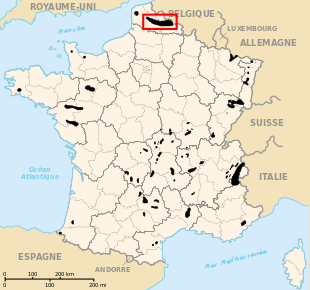Nord-Pas de Calais Mining Basin
| Nord-Pas de Calais Mining Basin | |
|---|---|
| Name as inscribed on the World Heritage List | |
|
Nord-Pas de Calais Mining Basin is an area of great architectural and landscape diversity. | |
| Type | Cultural |
| Criteria | ii, iv, vi |
| Reference | 1360 |
| UNESCO region | Europe |
| Coordinates | 50°27′45″N 3°32′46″E / 50.46250°N 3.54611°ECoordinates: 50°27′45″N 3°32′46″E / 50.46250°N 3.54611°E |
| Inscription history | |
| Inscription | 2012 (36th Session) |

Nord-Pas de Calais mining basin location on French coal basins map.
Nord-Pas-de-Calais Mining Basin is an area of France that has been added to the 2012 UNESCO World Heritage Sites list. This area has been shaped after three centuries of coal extraction from 18th century to 20th century and illustrates a significant period in the history of industrialisation in Europe.[1]
The 109 components of the World Heritage area include mining pits, lift infrastructure (headgears...), slag heaps, coal transport infrastructure, railway stations, workers’ estates and mining villages including social habitat, schools, religious buildings, health and community facilities, company premises, owners and managers’ houses, town halls.
 Fosse De Sessevalle in the 1930s.
Fosse De Sessevalle in the 1930s..jpg) Fosse #1 - 1 bis - 1 ter of Liévin colliery, ca. 1910.
Fosse #1 - 1 bis - 1 ter of Liévin colliery, ca. 1910.- Fosse #2 of Marles colliery.
- Miners housing, or corons, Cité De Sessevalle.
- Slag heap #93, called "21 Nord de Courrières".
References
External links
| Wikimedia Commons has media related to Bassin minier du Nord-Pas-de-Calais. |
This article is issued from Wikipedia - version of the 10/5/2016. The text is available under the Creative Commons Attribution/Share Alike but additional terms may apply for the media files.
